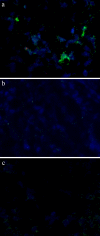Development of an in situ assay for simultaneous detection of the genomic and replicative form of PCV2 using padlock probes and rolling circle amplification
- PMID: 21261961
- PMCID: PMC3033839
- DOI: 10.1186/1743-422X-8-37
Development of an in situ assay for simultaneous detection of the genomic and replicative form of PCV2 using padlock probes and rolling circle amplification
Abstract
Background: In this study we utilized padlock probes and rolling circle amplification as a mean to detect and study the replication of porcine circovirus type 2 (PCV2) in cultured cells and in infected tissue. Porcine circovirus type 2 is a single-stranded circular DNA virus associated with several severe diseases, porcine circovirus diseases (PCVD) in pigs, such as postweaning multisystemic wasting syndrome. The exact reason and mechanisms behind the trigger of PCV2 replication that is associated with these diseases is not well-known. The virus replicates with rolling circle replication and thus also exists as a double-stranded replicative form.
Results: By applying padlock probes and rolling circle amplification we could not only visualise the viral genome but also discriminate between the genomic and the replicative strand in situ. The genomic strand existed in higher numbers than the replicative strand. The virus accumulated in certain nuclei but also spread into the cytoplasm of cells in the surrounding tissue. In cultured cells the average number of signals increased with time after infection.
Conclusions: We have developed a method for detection of both strands of PCV2 in situ that can be useful for studies of replication and in situ detection of PCV2 as well as of DNA viruses in general.
Figures





References
Publication types
MeSH terms
Substances
LinkOut - more resources
Full Text Sources

